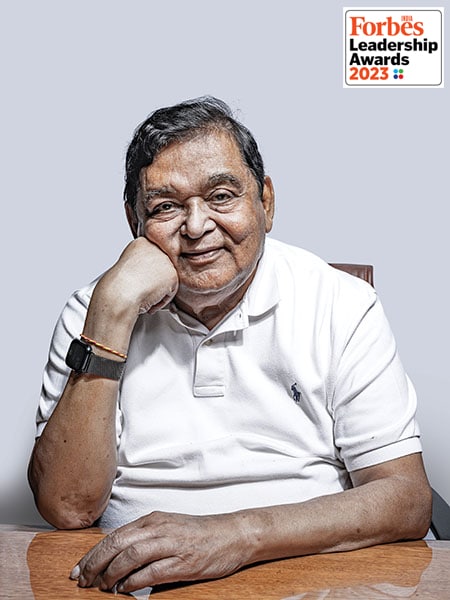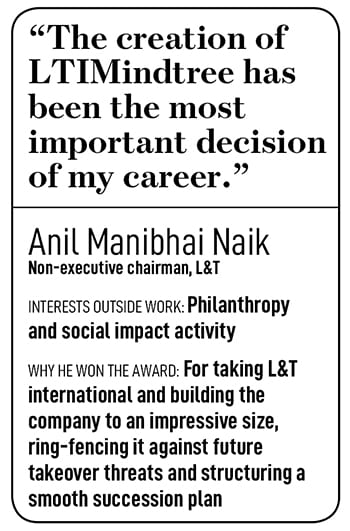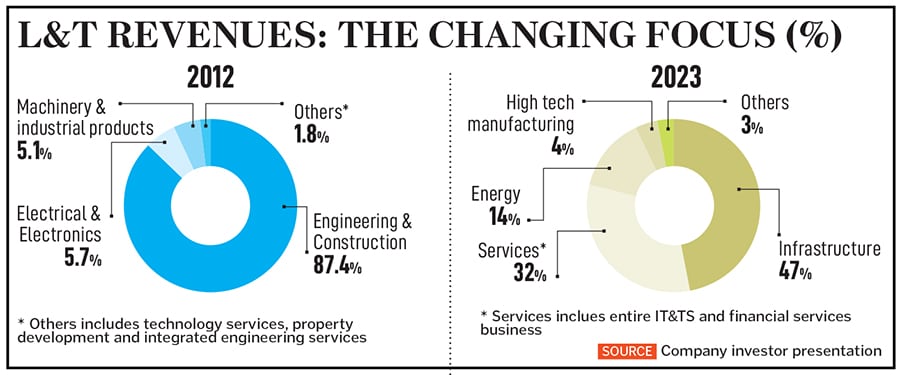
FILA 2023, Lifetime Achievement Award: AM Naik - The old-world leader and crisis man
By Salil Panchal| Mar 29, 2023
The journey of Naik and L&T's ascendency as a force to be reckoned with run parallel. Naik follows the old-world style of leadership, and he's built L&T to its impressive size, incubated fresh revenue lines and implemented a complex succession plan
 [CAPTION]AM Naik, non-executive chairman, L&T
Image: Mexy Xavier[/CAPTION]
[CAPTION]AM Naik, non-executive chairman, L&T
Image: Mexy Xavier[/CAPTION]
The narrative about how, in 2001, Anil Manibhai Naik, Larsen & Toubro’s (L&T) then-managing director and CEO, battled and thwarted Aditya Birla Group (ABG) Chairman Kumar Mangalam Birla’s attempt to take over L&T’s cement division is part of India’s corporate history. Birla had emerged as a serious acquirer after Reliance Industries [owner of Network 18, the publisher of Forbes India] sold its 10 percent stake to Birla, who had been purchasing L&T shares, resulting in a near-16 percent stake.
Forced to take a swift decision, Naik created the L&T Employees Welfare Foundation—the company had no active promoter earlier—and with the help of government circles devised a scheme through which L&T’s cement division was demerged and sold to Birla. The foundation (later renamed L&T Employees Trust) was allowed to buy the 14.95 percent stake which Grasim held in L&T and, by 2003, the deal was struck. ABG got control of the L&T cement business which helped it increase its share in the sector, and L&T—after selling a non-core business—became a stronger, professionally-run company after avoiding a takeover.
_RSS_The L&T Employees Trust’s stake is now 13.88 percent, and the value of the trust was estimated at ₹42,000 crore as of 2020, according to Naik.
L&T is not unfamiliar to being tracked. Dubai-based businessman, the late Manu Chhabria, in 1987, and Reliance Industries founder, the late Dhirubhai Ambani, had been picking up stakes in the company. Narottam Desai, L&T’s chairman from 1979 to 1989, saw Ambani as a ‘white knight’ to stall Chhabria, which did happen. Though Ambani wanted to play a more active role in L&T, it did not happen, as political forces did not support it, and after 1990, they were investors until the stake sale.
Minhaz Merchant’s 2017 book The Nationalist chronicles Naik’s journey as a leader and the transformation of L&T into a diversified multinational from its early years. Around 15 percent stake was with the foundation and another 15 percent through phase-wise stock options issued to individual employees, resulting in a 30 percent stake in L&T. “We thus ring-fenced it from future takeover attempts,” Naik, 80, tells Forbes India, recounting the deal, at his first-floor office at his residence, High Trees in Bandra, Mumbai.  Through this one strategic move, Naik became recognised within the company, to the corporate world outside and policymakers as an iconic and fearless leader who cannot be taken lightly when pushed to the wall.
Through this one strategic move, Naik became recognised within the company, to the corporate world outside and policymakers as an iconic and fearless leader who cannot be taken lightly when pushed to the wall.
Much of this fearlessness was visible even when he joined L&T. Naik recounts a conflict which he resolved in the late 1970s. “The general manager (administration) at our Powai factory hid in my room when angry unions were marching towards his office gate. I told him to go back to his room (in the neighbouring building) and went to the gate to meet the unions. On my word, they disbursed. That was respect,” he recalls.
Naik also remembers his early experiences with student politics and building leadership skills, having won several elections at the Birla Vishwakarma Mahavidyalaya (BVM) Engineering College at Vallabh Vidyanagar town in Gujarat while studying mechanical engineering.
A multi-decades-long leadership stint usually illustrates impressive earnings growth for a corporate. Naik, one of the 12 Indians in business and trade to be awarded the Padma Vibhushan [India’s second-highest civilian award], has led L&T’s gross revenues to rise over 21x to ₹156,500 crore in 2022 from ₹7,291 crore in 1999 when he took charge as CEO (see box). In the same period, its market capitalisation has risen 150x to ₹262,000 crore from ₹2,000 crore.
Going Multinational and Restructuring
The early years of L&T’s presence in India commenced with dairy equipment, as a representative of manufacturers in Europe, a legacy of its Danish founder-engineers Henning Holck-Larsen and Søren Kristian Toubro. This was followed by the company manufacturing switchgears and being a supplier of seals for bottles, breweries and pharmaceuticals. A lot of these non-core, loss-making businesses, like glass bottles and leather shoes, were sold off by 2003, alongside the cement business.
The journey of Naik and L&T’s ascendency as a force to be reckoned with run parallel. Engineering and construction (E&C) became the cornerstone of the company’s growth from the mid-1950s onwards. L&T’s strength has been to be a market leader in building several civil engineering projects, nuclear power plants and defence equipment. But the strategy to offer turnkey execution of an entire project, compared to just fabrication, was a success story.
E&C contributed just under 59 percent of revenues when Naik became CEO in 1999, 87 percent midway through Naik’s leadership in 2012 and 47 percent in 2022. In recent decades, L&T has focussed more on technology, with IT&TS (technology services) and financial services contributing 32 percent to revenues in December 2022.
Also read: Isha Ambani wins GenNext Entrepreneur award at Forbes India Leadership Awards 2023
The Nationalist also records one of Naik’s earliest strategic decisions, under the chairmanship of Desai, was to identify and convert—during the early 1980s—a 755-acre waterlogged marshland into a sophisticated factory manufacturing high-technology equipment for nuclear powered submarines, nuclear reactors and aerospace equipment. Naik, then joint general manager, was led by another enterprising engineer and senior VP Yogeshchandra Trivedi, under the guidance of another L&T veteran, Vijay Kumar Magapu, who later led the IT subsidiary L&T Infotech.
Hazira— L&T’s manufacturing facility in Gujarat which is involved in heavy engineering, defence & shipbuilding, and power equipment manufacture—is recognised for building the hull of INS Arihant, India’s first nuclear-powered ballistic missile submarine, at the shipbuilding facility there.
But it was Naik’s vision to take L&T international, particularly to the Middle East, that changed the landscape for the company. When he took charge, business from overseas was barely 3 percent, as noted in Merchant’s book. International orders form 26 percent (₹102,100 crore) of the 9MFY23 total order book of ₹386,600 crore, and in the same period, 37 percent of total revenues came from overseas.
“Diversifying from India, and particularly to the Middle East, has been his key initiative,” says Sumit Kishore, executive director (capital goods, power & infrastructure) at Axis Capital. The Middle East region constitutes 21 percent of L&T’s order book. The company has established a strong presence in the Gulf region, particularly through the development of hydrocarbons, power transmission and water treatment plants.
In a corporate history spanning over 76 years, the group had 152 businesses and 25 companies, which would be impossible for one man to govern. So, in 2011, Naik announced the restructuring of L&T into nine independent companies, each of which would have their own CEO, CFO, board of directors—who would report to him—and balance sheets.
The aim, of course, besides improving governance and efficiency, was to provide a chance for each company to unlock shareholder value through future listings.
Incubating Infotech, Realty
Before some of the independent companies could think of listings, Naik had to lay down plans for their growth path and meet challenges. More than diversification, it was attrition—the losing of engineers from L&T to competition—which led Naik to focus extensively on growing the information technology business in the group. Having seen how competitive and large the outsourcing companies of Infosys, TCS, Wipro and HCL Tech had grown since the mid-1990s, L&T almost had no choice but to start protecting its turf aggressively.
“We had a 60 percent attrition rate from our captive IT department at one point,” says Naik. This business, with SAP as a backbone, was involved in digitising L&T. “I decided to offer better salaries to software engineers and make IT as a separate business,” he adds. In 2016, L&T Infotech and the pure-play engineering services firm L&T Technology Services (LTTS) were listed independently.
Naik considers the creation of LTIMindtree—through LTI (formerly L&T Infotech) acquiring Mindtree in 2019—as the most “important” decision in his career. L&T, in previous decades, largely grew organically but it needed to scout for acquisitions in the IT space to grow in size and compete with the likes of Infosys, TCS or Wipro.
Also read: L&T Defence's digitisation is finally paying off
Kishore of Axis Capital says: “Naik can be credited for incubating the IT & technology services and the realty businesses. IT&TS stabilises growth for L&T considering that infrastructure projects and manufacturing businesses are capex-linked and dependent on government capex spends in a big way. Growth for the company becomes more broad-based through IT & TS.”
The LTI-Mindtree deal got unwanted attention when one of its non-executive directors, Café Coffee Day founder, the late VG Siddhartha, approached L&T to offer his 21 percent stake, which L&T lapped up. Naik maintains the acquisition was not “hostile”, and it is already a force to reckon with. The IT & TS segment, including LTIMindtree, now contributes over 22 percent to L&T’s total revenues of ₹46,390 crore for Q3FY23.
LTIMindtree is expected to continue to grow in size, but attrition rates continue to remain worrisome at 22.3 percent in Q3FY23 compared to 17 percent in Q4FY17 for L&T Infotech, prior to the deal. HDFC Securities’ analysts Apurva Prasad, Amit Chandra and Vinesh Vala, in a January 21 note to clients, said, “LTIMindtree (LTIM) can take market share from Tier 1 IT (LTIM 5 percent of India Tier 1 IT, but 8 to 10 percent share of incremental growth). LTIM expects $1 billion in revenue synergies over four to five years and around 200 basis points cost synergies.”
L&T Realty, the other business vertical which Naik has incubated, plans to capitalise on the demand for new premium homes in Mumbai and Bengaluru, besides keeping a select presence in Hyderabad, Pune and the Delhi-NCR region. L&T Realty’s CEO and Managing Director Shrikant Joshi has told the media that the company plans to add 5 million square feet each year over the next five years. Kishore says that though some of the businesses, such as realty, are still small in terms of a percentage of revenues, L&T has inventory in Mumbai, Bengaluru and Chennai. “Being a strong brand, it has been able to achieve timely closure of projects,” he explains.
Also read: India can not only be the world's richest, but also the most inclusive economy by 2047: Rajiv Shah
An Effective Successor
Naik has been credited with implementing a smooth succession plan. SN Subrahmanyan, L&T’s managing director and CEO [since 2017], has, since 2015, been identified by Naik as a successor, having successfully led the infrastructure business at L&T Construction, the Hyderabad Metro project and then the LTI and technology services verticals. “SNS is a dynamic leader… he has a passion,” Naik observes.
Naik says he plans to step aside from the L&T board in October, but is yet to inform the board members. He will continue to be chairman of the L&T Employees Trust and work one more year at LTTS, LTIMindtree and L&T Realty up to June 2025. “Then I will give up everything except the Trust and the honorary Council General of Denmark post,” he says. This will give the octogenarian more time to devote towards philanthropy.
Axis Capital’s Kishore believes that, in keeping with the Lakshya 2026 five-year plan, the focus will continue to be towards infrastructure projects, IT&TS, high-tech manufacturing (electrolysers, battery manufacturing), and defence. Abhineet Anand from Emkay Global Securities says the government has “maintained its strong capex momentum; during April to February 2022, its capex growth stood at 29 percent YoY, and at 25 percent on a four-year CAGR basis. Overall, around 78 percent of the budgeted capex has been carried out in the first 10 months of FY23”.
Naik’s legacy in the form of unending commitment towards the development and growth of L&T will stand. The organisational restructuring and succession plans are fully operative and mean that Naik’s imprint will never be forgotten. In Subrahmanyan, who has worked in L&T for 39 years, the company will see continuity in leadership skills, analysts say.